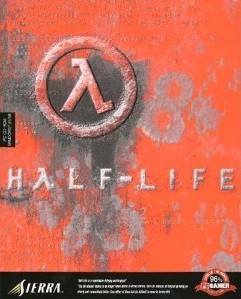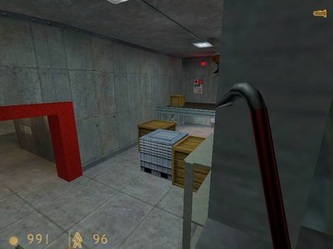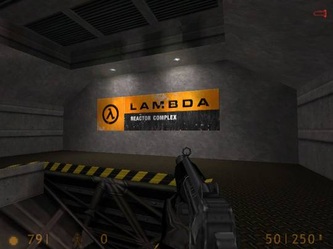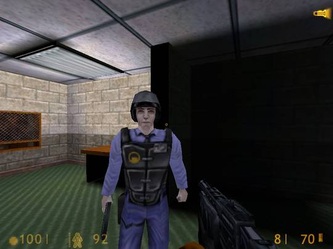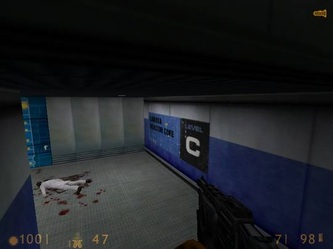HALF-LIFE (PC)
A Pentium 133Mhz was the business back in 1996, although now days it would likely be out-performed by a twenty quid toaster from Argos! Still, you could play some pretty top notch games on such a system; Command & Conquer (pure simplicity), Sam & Max (point and click dreamland), Syndicate Wars (neutron bomb juggling awesomeness) and Ultima Underworld (quite simply no Ultima Underworld, no Bioshock). Yet as good as these games are they have all been replaced by more superior creations in their genres over the sands of time. Well, except for one game, which is still as fresh, invigorating and original as it was when first released at the tail end of 1998. Many first person shooters have been made in the intervening years with ever flashier graphics (and dull gameplay – looking at you Modern Warfare), but few have even come close to matching the experience Valve unleashed upon the world with the Black Mesa Research Facility, resonance cascades, Vortigaunts, the G-Man and a little known title character called Gordon Freeman. Half-Life was born. Better than that, it actually managed to run on a P133!
Gordon Freeman is the latest acquisition to the Black Mesa Research Facility; a theoretical scientist of some clout who is part of the anomalous materials team. Today is like any other day for Gordon - late arrival, technical glitches to the communications mainframe, more specimens to analyse. Yawn inducing! Yet things get rather exciting when the normal routine of placing a specimen into the scanning beam inadvertently creates a resonance cascade, opening a portal between earth and an alien dimension. On awaking from the temporal displacement (Gordon is teleported to an alien planet and back again), he finds that the research facility is falling apart around him, alien creatures are tearing his science colleagues a new one, and the military rescue team that have taken control of the facility are killing all in their path in an effort to cover up the 'incident'. Gordon decides on a course of action that one would expect of any theoretical scientist - grab a shotgun and blast your way out! Instructed to head for the Lambda complex on the far side of the facility for reasons unknown, Gordon must confront human and alien foe alike, traverse rail networks, missile silos, sewers, office buildings, blast pits and mountain ranges, before attempting to close the resonance cascade; saving not only Black Mesa but the whole world at large.
So, as Gordon Freeman (the significance of his surname is elaborated on in the sequel) you are placed in the free-falling hell of the research facility with only a Hazardous Environmental suit, Barney the security guard, whatever weaponry you can muster (including the now iconic crow-bar) and your own wits for company through 19 rather extensive chapters. But unlike all previous first person shooters Half-Life is no Doom clone; it's much more intelligent than that. Certainly you get to blow shit up and such like, but whereas Doom (and later the Quake franchise) was a straightforward 'there's something moving, shoot it' kind of game, it wasn't particularly immersive and suffered from bouts of repetitiveness in structure that led to a more diluted gaming experience. Half-Life instead took the best elements that first made Doom a revolutionary title (a great blast, bloody scary) and refined them into something much more subtle, engaging and innovative.
Firstly, the structure and design of the game is co-ordinated in such a fashion that getting from point A to point B derives a greater more fulfilling purpose. Gone are the objective based platitudes of most similar shooters; story progression is key here making for a much more immersive experience. Indeed, by not incorporating levels, cut-scenes or an inventory page (everything can be done from the main game screen) and keeping everything within Gordon's eye-view, it ensures you remain involved as the character throughout. Whilst Gordon is never seen and never actually speaks, he certainly interacts. Scientists speak to you as Gordon, members of the rescue team bitch about you for killing their mates, and then the mysterious G-Man appears every so often. Who is he? You want to find out and this systematically drives the game onwards in an unrelenting, unforgettable way.
This is only bettered by the successful balance between puzzle solving and combat that proves distinctive from anything that had gone before. By being more than just a shoot 'em up, Half-Life successfully tells tedium to take a hike. The puzzles themselves are not particularly arduous and cause minimal frustration, but they really stand out thanks to their innovative design. Refraining from the whole 3D map maze where switches need to be flicked to open doors, Valve's idea of a puzzle can be seen in one particular scenario. How does one progress past and remove three plant-like creatures housed in a last pit that can't see but can sense by sound? An outstanding sequence sets up the puzzle - a scientist being dragged off and munched by one of the creatures is immediately unnerving! The fact you have to then enter the blast bit and tip-toe round (or throw a grenade as a distraction) to avoid the piercing beaks of these beasts derives much satisfaction (and pure adrenaline pumping terror) once achieved.
The typical FPS weapons are all on show, from the MP5, shotgun and magnum, to the stupidly powerful rail gun. A few alien weapons are included later on, but this is merely for starters. What actually makes the combat in Half-Life such a joy is the wonderful artificial intelligence employed and, more importantly, the bravado of the superbly implemented scripted sequences. Enemies no longer wander straight into your sights, but instead put up a pretty good fight. Rescue team members out-flank you, throw grenades and are a general nuisance; something not previously witnessed in the genre. Vortigaunts hide round corners preparing for ambush and head-crabs appear suddenly from darkened air vents adding a general air of squeaky-bum time to proceedings. It all makes for a wonderful concoction of cerebral encounters. Indeed, avoid playing Half-Life on the easiest difficulty setting as the many surprises the game has to offer are otherwise ruined on the more hardcore settings.
The scripted sequences are also spectacularly awesome. Ranging from scientists being dragged into air vents by alien monsters before body parts are spat out in wonderfully graphic gore; to the G-Man looking at you through a window and straightening his tie before walking off; to specific combat sequences set-off once you reach particular areas (each combined with an adrenaline pumping music cue); all are superbly conveyed and just add to the game's multi-layered atmosphere. When you talk about a computer game playing out like a film with you, the player, starring in the lead role, Half-Life is that game! It's an action movie and horror flick rolled into one and for full effect turn up the volume, turn off the lights and prepare to cream in your jeans with joy at the magnificent encounters along the way.
This is only bettered by the successful balance between puzzle solving and combat that proves distinctive from anything that had gone before. By being more than just a shoot 'em up, Half-Life successfully tells tedium to take a hike. The puzzles themselves are not particularly arduous and cause minimal frustration, but they really stand out thanks to their innovative design. Refraining from the whole 3D map maze where switches need to be flicked to open doors, Valve's idea of a puzzle can be seen in one particular scenario. How does one progress past and remove three plant-like creatures housed in a last pit that can't see but can sense by sound? An outstanding sequence sets up the puzzle - a scientist being dragged off and munched by one of the creatures is immediately unnerving! The fact you have to then enter the blast bit and tip-toe round (or throw a grenade as a distraction) to avoid the piercing beaks of these beasts derives much satisfaction (and pure adrenaline pumping terror) once achieved.
The typical FPS weapons are all on show, from the MP5, shotgun and magnum, to the stupidly powerful rail gun. A few alien weapons are included later on, but this is merely for starters. What actually makes the combat in Half-Life such a joy is the wonderful artificial intelligence employed and, more importantly, the bravado of the superbly implemented scripted sequences. Enemies no longer wander straight into your sights, but instead put up a pretty good fight. Rescue team members out-flank you, throw grenades and are a general nuisance; something not previously witnessed in the genre. Vortigaunts hide round corners preparing for ambush and head-crabs appear suddenly from darkened air vents adding a general air of squeaky-bum time to proceedings. It all makes for a wonderful concoction of cerebral encounters. Indeed, avoid playing Half-Life on the easiest difficulty setting as the many surprises the game has to offer are otherwise ruined on the more hardcore settings.
The scripted sequences are also spectacularly awesome. Ranging from scientists being dragged into air vents by alien monsters before body parts are spat out in wonderfully graphic gore; to the G-Man looking at you through a window and straightening his tie before walking off; to specific combat sequences set-off once you reach particular areas (each combined with an adrenaline pumping music cue); all are superbly conveyed and just add to the game's multi-layered atmosphere. When you talk about a computer game playing out like a film with you, the player, starring in the lead role, Half-Life is that game! It's an action movie and horror flick rolled into one and for full effect turn up the volume, turn off the lights and prepare to cream in your jeans with joy at the magnificent encounters along the way.
Sure, Half-Life does look a little dated when compared to more recent FPS fare, in particular its marvellous sequel. And yes, some of the graphics are dire - the underwater beast an obvious example - but for its time this was top of the range stuff. The superb introduction with Gordon being carried through a variety of environments on the internal rail system, whilst the film style credits roll, is still fantastically impressive (and much copied), and the alien homeworld sequence remains a stand out. A wonderfully visualised landscape of floating platforms and crisp, coloured space, littered with corpses of previous interlopers from Black Mesa and pierced by an eerie silence for the most part, makes for a more than fitting finale. For some, the low-key finale is a little underwhelming, but ignore these tools as it’s the perfect example of less is so much more.
The true quality of a game should perhaps be measured on its longevity and influence. Now almost 15 years since release and looking back retrospectively, it's difficult to disagree with the critics of the time about how revolutionary a game Half-Life was. Without it the first person shooter would likely have evolved much more slowly. It injected intelligence into the genre which made it more compelling and addictive than the likes of Quake and with its movie like qualities added a flair and style that was previously much overlooked. That it has influenced pretty much every atmospheric first-person shooter that's followed, from Deus-Ex to F.E.A.R. to Halo, is pretty much undoubted. That few of these games have bettered it is ever more impressive. And today, Half-Life is still as much fun to play as it was back in the day, thanks to its subtle refined craft, immense gameplay mechanics and intelligence and the exquisitely conceived plotting.
So, if you are yet to embrace the H.E.V suit, have failed to pick up a crow bar and are still waiting to commit your first resonance cascade, then you really should investigate this exquisite piece of gaming. Not only is Half-Life one of the finest first person shooters ever crafted, it remains one of the finest games ever made, period.
The true quality of a game should perhaps be measured on its longevity and influence. Now almost 15 years since release and looking back retrospectively, it's difficult to disagree with the critics of the time about how revolutionary a game Half-Life was. Without it the first person shooter would likely have evolved much more slowly. It injected intelligence into the genre which made it more compelling and addictive than the likes of Quake and with its movie like qualities added a flair and style that was previously much overlooked. That it has influenced pretty much every atmospheric first-person shooter that's followed, from Deus-Ex to F.E.A.R. to Halo, is pretty much undoubted. That few of these games have bettered it is ever more impressive. And today, Half-Life is still as much fun to play as it was back in the day, thanks to its subtle refined craft, immense gameplay mechanics and intelligence and the exquisitely conceived plotting.
So, if you are yet to embrace the H.E.V suit, have failed to pick up a crow bar and are still waiting to commit your first resonance cascade, then you really should investigate this exquisite piece of gaming. Not only is Half-Life one of the finest first person shooters ever crafted, it remains one of the finest games ever made, period.
|
VERDICT
Visual: 8/10
Audio: 9/10 Gameplay: 10/10 Longevity: 10/10 OVERALL: 10/10 Screens by arkena |
